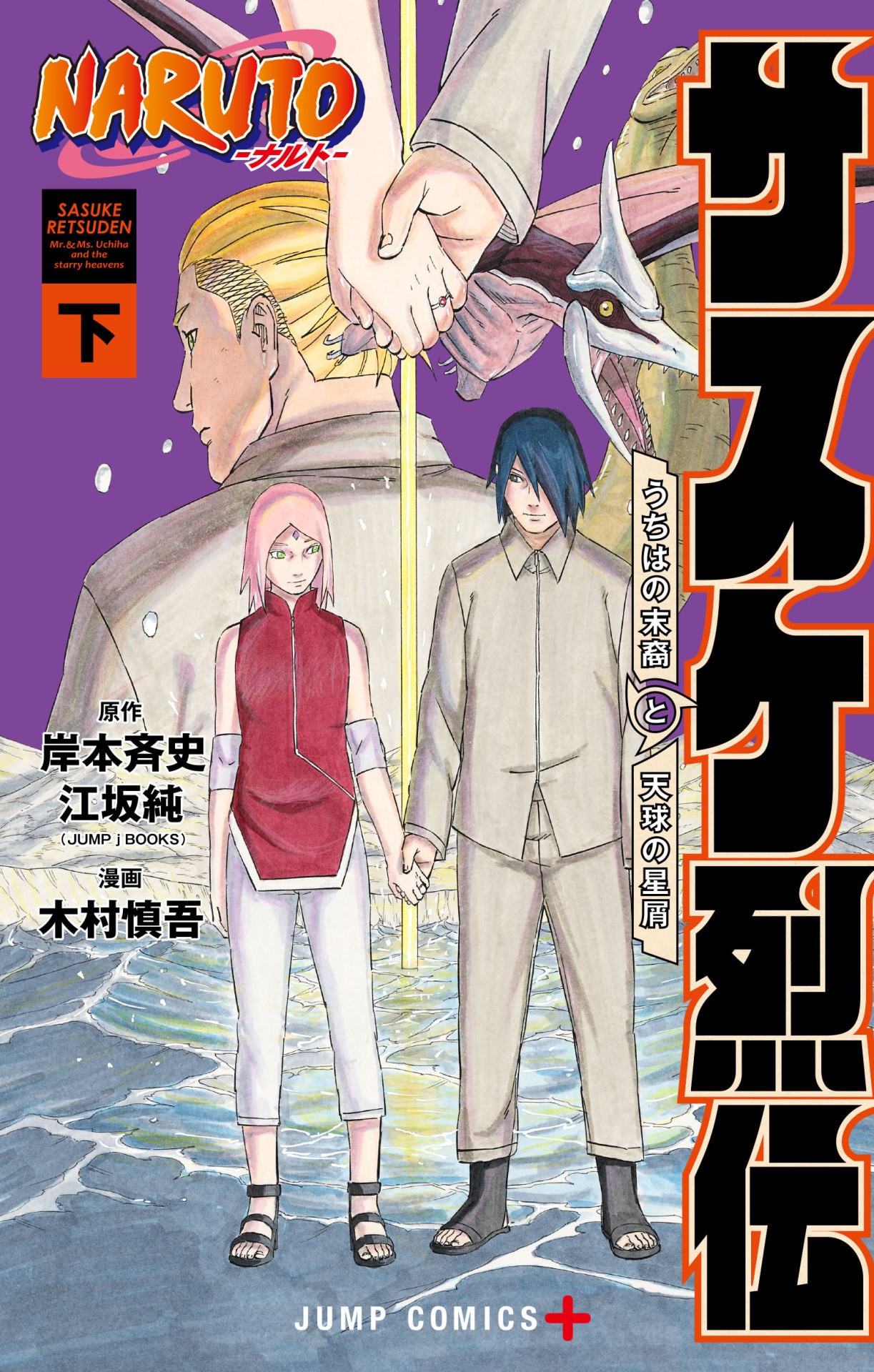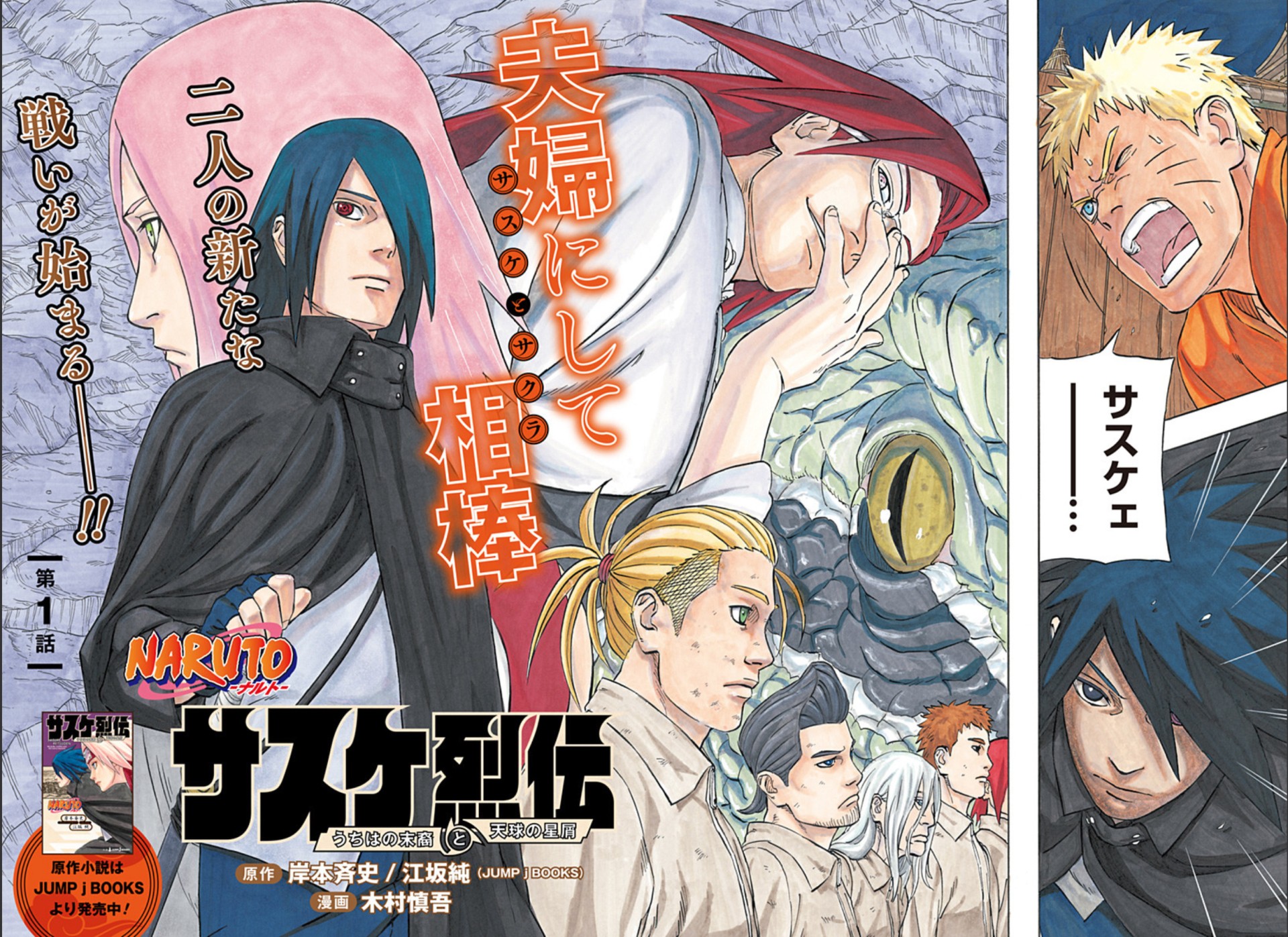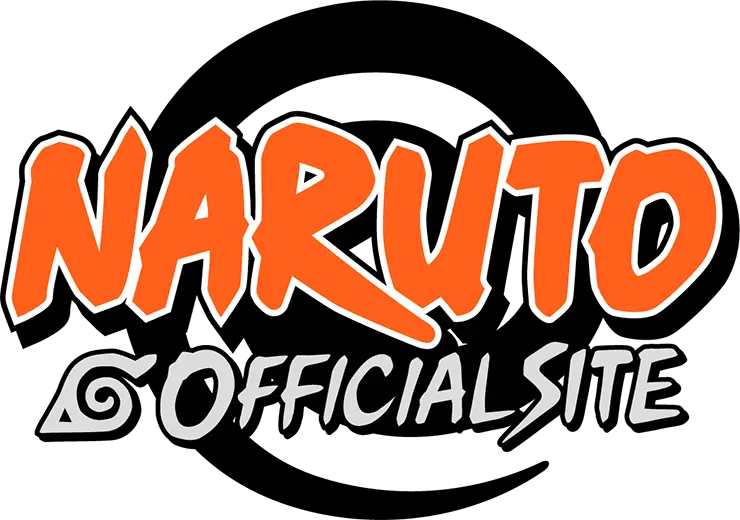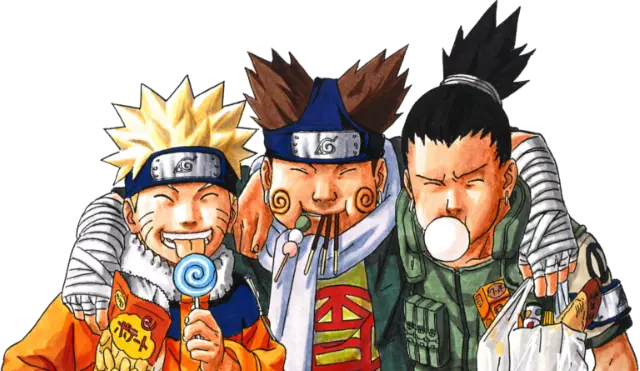
Manga & Related Works
06/09/2023
Shingo Kimura, Artist of Sasuke's Story, Reveals the Impact Being Introduced to NARUTO Had on Him. "It All Comes Back to Kishimoto. I Teared Up Just Imagining Meeting Him (Laughs)."
Naruto: Sasuke's Story–The Uchiha and the Heavenly Stardust (hereafter, Sasuke's Story) was serialized in Shonen Jump+ and MANGA Plus. Set after the Fourth Great Ninja War, Sasuke Uchiha (hereafter, Sasuke) travels to the secluded land of Redaku in order to search for clues about the illness plaguing Naruto Uzumaki (hereafter, Naruto). The second and final volume is now on sale. We sat down with the artist in charge of this story, Shingo Kimura, to ask him about his first encounter with the world of NARUTO. (Part 1 of 3)

Reading NARUTO at My Friend's House Left a Major Impact on Me
—Before you became the artist for Sasuke's Story, what kind of life did you lead as a manga creator?
My sister was really good at drawing. She used to draw pictures of a Kamen Rider figure I had for me, and I would try to draw it myself using her pictures as a reference. This was when I was about three or four years old.
After that, I started watching the anime Fullmetal Alchemist (Square Enix), and found out that it was originally a manga.
In the second grade of elementary school when I was told to write down my dreams for the future, I thought, "I want to have a job that involves drawing, but I don't know how to become an artist." However, becoming a manga creator felt more approachable to me. In reality, it's not like I had some special connection to that profession either, but that's what I wrote down. After that, I became very conscious of them (manga creators).
—When did you first encounter NARUTO?
When I was in third grade, I went over to a friend's house and there was a volume of NARUTO lying around. That was my first exposure to the series.
Most of the manga I had read until that point used a lot of screentones in the art, but NARUTO hardly used any at all. I remember being shocked, thinking, "It's just black and white, so why does it feel so cool and alive?"
I started collecting the volumes after that, and when I was in middle school I started buying copies of Weekly Shonen Jump (hereafter, Jump).
My sister was really good at drawing. She used to draw pictures of a Kamen Rider figure I had for me, and I would try to draw it myself using her pictures as a reference. This was when I was about three or four years old.
After that, I started watching the anime Fullmetal Alchemist (Square Enix), and found out that it was originally a manga.
In the second grade of elementary school when I was told to write down my dreams for the future, I thought, "I want to have a job that involves drawing, but I don't know how to become an artist." However, becoming a manga creator felt more approachable to me. In reality, it's not like I had some special connection to that profession either, but that's what I wrote down. After that, I became very conscious of them (manga creators).
—When did you first encounter NARUTO?
When I was in third grade, I went over to a friend's house and there was a volume of NARUTO lying around. That was my first exposure to the series.
Most of the manga I had read until that point used a lot of screentones in the art, but NARUTO hardly used any at all. I remember being shocked, thinking, "It's just black and white, so why does it feel so cool and alive?"
I started collecting the volumes after that, and when I was in middle school I started buying copies of Weekly Shonen Jump (hereafter, Jump).
Jam-Packed With Stuff I Love

—Let me guess, Kishimoto is the manga creator who influenced you the most?
That's right. If I were to talk about his strong points we would be here all day, but if I just picked one, it would be how he perfectly blends the cool three-dimensionality of seinen manga and the pop-style cuteness of shōnen manga. The story is engaging and the character designs are absurdly awesome.
Since I was young I've always liked things with more realistic styles. I think most people had a Pokémon phase as a child, but I was never really all that interested in it.
I was more into fighting games like Dead or Alive or Tekken, though I was mostly playing them because I really liked the motions, such as knocking the enemy back so they fall down and then pressing in on them.
When the Fullmetal Alchemist anime aired in 2003, the opening and the big battle scenes featured characters with very smooth animations, and I recall thinking, "This is so cool, what is it?" I liked those kinds of realistic movements so much that I even tried to imitate them myself.
The manga that really got me hooked was NARUTO. It had pretty much everything I'd been looking for, everything I loved. It was almost like it was made for me.
—As you commented on the dust cover of the first volume, you started buying not only volumes of the manga, but Jump issues as well. Why was that?
I still remember that in 2012, the 34th and 35th issues both had NARUTO cover art. I saw the 35th issue displayed in a convenience store, and it had a really impressive cover.
That's right. If I were to talk about his strong points we would be here all day, but if I just picked one, it would be how he perfectly blends the cool three-dimensionality of seinen manga and the pop-style cuteness of shōnen manga. The story is engaging and the character designs are absurdly awesome.
Since I was young I've always liked things with more realistic styles. I think most people had a Pokémon phase as a child, but I was never really all that interested in it.
I was more into fighting games like Dead or Alive or Tekken, though I was mostly playing them because I really liked the motions, such as knocking the enemy back so they fall down and then pressing in on them.
When the Fullmetal Alchemist anime aired in 2003, the opening and the big battle scenes featured characters with very smooth animations, and I recall thinking, "This is so cool, what is it?" I liked those kinds of realistic movements so much that I even tried to imitate them myself.
The manga that really got me hooked was NARUTO. It had pretty much everything I'd been looking for, everything I loved. It was almost like it was made for me.
—As you commented on the dust cover of the first volume, you started buying not only volumes of the manga, but Jump issues as well. Why was that?
I still remember that in 2012, the 34th and 35th issues both had NARUTO cover art. I saw the 35th issue displayed in a convenience store, and it had a really impressive cover.

But I was in the "buying the volumes" faction at the time, so since the story (in Jump) was ahead of them, I was hesitant to actually buy it... I ended up flipping through the magazine after walking around the store a couple times. The colored cover page was great, and there were a bunch of cool color pages in the manga as well, so in the end I gave in, and that's when I started buying Jump.
Learning About the Tezuka Award
—Did Jump have a different appeal than the volumes?
The color pages were left unaltered (in the volumes they were black and white), and the larger page size had a real impact.
Also, I learned about various manga awards, and noticed Masashi Kishimoto was one of the judges for the Tezuka Award. I started thinking things like "If I submit something, will he read it?" and "I really want to enter something someday."
But while I was in middle school, I was so busy with my school club and cram school, I had no time at all to draw manga. It was so stressful that when I got into high school I decided to swear off clubs entirely.
After starting high school, I would go straight home as soon as classes ended and spend six to seven hours a day just practicing by copying manga. I loved not only NARUTO but also Blade of the Immortal, and ended up entirely focused on copying things like those.
—Six to seven hours a day is pretty incredible. You spent most of that time essentially copying?
I drew some original compositions, but it was mostly copying, yes. Kishimoto was actually the reason I started to like Blade of the Immortal, too. Around the time that NARUTO's serialization ended, Kishimoto had a publicized conversation with the author of Blade of the Immortal, Hiroaki Samura, and said, "I was heavily influenced by it. The action scenes are very cool."
I immediately bought volumes 13 and 14 on the way back from school. After I started reading I got so invested that I bought all the remaining volumes the following week, and from there I was completely hooked.
The color pages were left unaltered (in the volumes they were black and white), and the larger page size had a real impact.
Also, I learned about various manga awards, and noticed Masashi Kishimoto was one of the judges for the Tezuka Award. I started thinking things like "If I submit something, will he read it?" and "I really want to enter something someday."
But while I was in middle school, I was so busy with my school club and cram school, I had no time at all to draw manga. It was so stressful that when I got into high school I decided to swear off clubs entirely.
After starting high school, I would go straight home as soon as classes ended and spend six to seven hours a day just practicing by copying manga. I loved not only NARUTO but also Blade of the Immortal, and ended up entirely focused on copying things like those.
—Six to seven hours a day is pretty incredible. You spent most of that time essentially copying?
I drew some original compositions, but it was mostly copying, yes. Kishimoto was actually the reason I started to like Blade of the Immortal, too. Around the time that NARUTO's serialization ended, Kishimoto had a publicized conversation with the author of Blade of the Immortal, Hiroaki Samura, and said, "I was heavily influenced by it. The action scenes are very cool."
I immediately bought volumes 13 and 14 on the way back from school. After I started reading I got so invested that I bought all the remaining volumes the following week, and from there I was completely hooked.
Receiving the Tezuka Award for His Graduation Project
—After graduating high school, I'm told you went straight into an art school.
I happen to hail from Gunma, and I entered an art design program at a junior college in Kiryu, where I drew manga and learned about things like illustration and painting.
I submitted the manga I drew for my graduation project for the Tezuka Award and received a prize.
(95th Tezuka Award runner-up prize, given for the manga Kuimodoshi)
I happen to hail from Gunma, and I entered an art design program at a junior college in Kiryu, where I drew manga and learned about things like illustration and painting.
I submitted the manga I drew for my graduation project for the Tezuka Award and received a prize.
(95th Tezuka Award runner-up prize, given for the manga Kuimodoshi)

—Apparently Kishimoto had a big hand in that decision.
At the time I couldn't believe it, I thought I was dreaming or something. I still remember the very moment the editor in charge of me handed me that issue of Jump. While I was waiting to change trains on the way back home from Tokyo, I looked at the page that announced the winners and saw that a message from Kishimoto was there.
In that section, the judges usually write things like "this is how things went this time", but I rarely saw remarks about a specific work, so I was taken aback when I saw " Kuimodoshi" written there.
—When did you first meet Kishimoto?
It was at the award ceremony for the Tezuka Award. The first thing he said to me was "You're incredibly good at drawing", which made me even more nervous. It was before COVID happened, so I was able to shake his hand.
This might be a little bit creepy, but when I was working late at night on the manga I submitted, I would think, "If I send this in for the Tezuka Award and get selected, I'll get to meet Kishimoto" and tear up just from imagining it. However, when I actually met him, I didn't cry even a little. My power of imagination back then was pretty scary (laughs).
I even use the date of our first meeting as the lock code for my phone.
—Should you really be telling us that? (laughs)
It'll be fine. My identity really is completely derived from Kishimoto. Akira, Blade of the Immortal, Production I.G's Ghost in the Shell, and Jin-Roh: The Wolf Brigade—I love all of those. For me, it really all comes back to Kishimoto.
Read part 2 here
Read part 3 here
Shingo Kimura
Manga Creator
Born in Gunma Prefecture. Graduated from Kiryu University Junior College's Department of Art and Design. Runner-up in the 95th Tezuka Awards. His debut manga was the one-shot Kuimodoshi which appeared in the September 2018 issue of Jump SQ. Since 2022, he has been the artist for Naruto: Sasuke's Story–The Uchiha and the Heavenly Stardust, serialized on Shonen Jump+ and MANGA Plus (story by Masashi Kishimoto and Jun Esaka, original novel published by JUMP j BOOKS).
Interview and Article: Asami Sato
At the time I couldn't believe it, I thought I was dreaming or something. I still remember the very moment the editor in charge of me handed me that issue of Jump. While I was waiting to change trains on the way back home from Tokyo, I looked at the page that announced the winners and saw that a message from Kishimoto was there.
In that section, the judges usually write things like "this is how things went this time", but I rarely saw remarks about a specific work, so I was taken aback when I saw " Kuimodoshi" written there.
—When did you first meet Kishimoto?
It was at the award ceremony for the Tezuka Award. The first thing he said to me was "You're incredibly good at drawing", which made me even more nervous. It was before COVID happened, so I was able to shake his hand.
This might be a little bit creepy, but when I was working late at night on the manga I submitted, I would think, "If I send this in for the Tezuka Award and get selected, I'll get to meet Kishimoto" and tear up just from imagining it. However, when I actually met him, I didn't cry even a little. My power of imagination back then was pretty scary (laughs).
I even use the date of our first meeting as the lock code for my phone.
—Should you really be telling us that? (laughs)
It'll be fine. My identity really is completely derived from Kishimoto. Akira, Blade of the Immortal, Production I.G's Ghost in the Shell, and Jin-Roh: The Wolf Brigade—I love all of those. For me, it really all comes back to Kishimoto.
Read part 2 here
Read part 3 here
Shingo Kimura
Manga Creator
Born in Gunma Prefecture. Graduated from Kiryu University Junior College's Department of Art and Design. Runner-up in the 95th Tezuka Awards. His debut manga was the one-shot Kuimodoshi which appeared in the September 2018 issue of Jump SQ. Since 2022, he has been the artist for Naruto: Sasuke's Story–The Uchiha and the Heavenly Stardust, serialized on Shonen Jump+ and MANGA Plus (story by Masashi Kishimoto and Jun Esaka, original novel published by JUMP j BOOKS).
Interview and Article: Asami Sato
This site includes machine-translated texts for some news articles. Please be aware that you might find some unusual expressions that are difficult to understand.
関連記事


